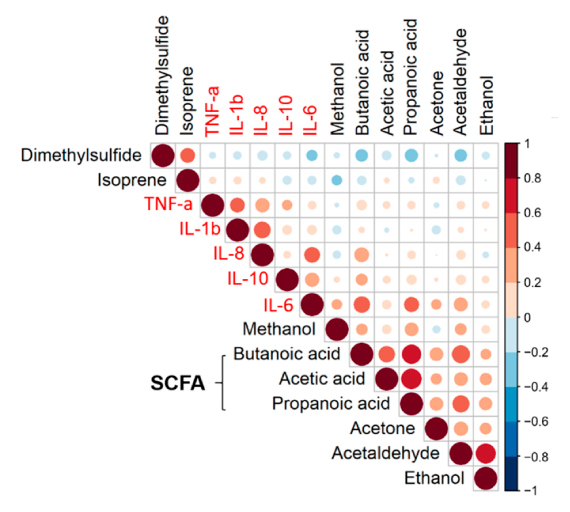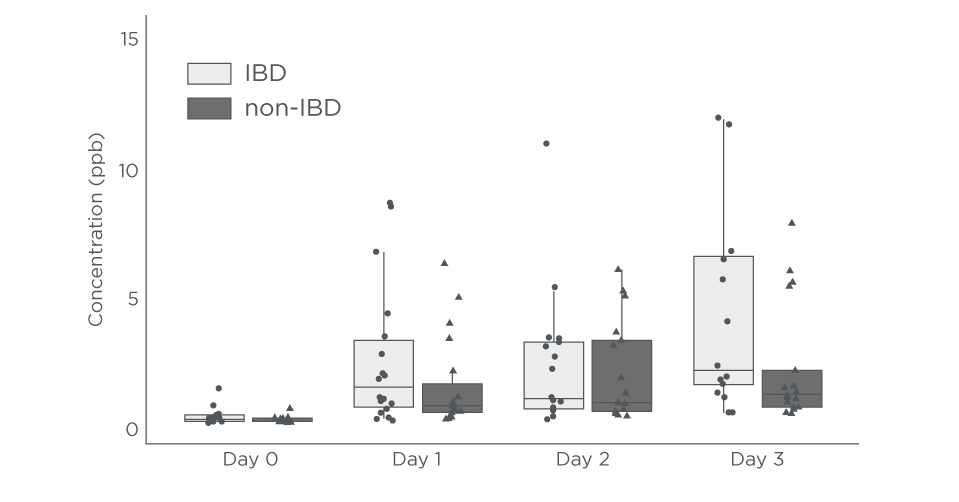Monitoring exercise induced inflammation in IBD patients
Exhaled VOCs matched favorably against known blood markers of inflammation
| Publication information: Henderson et al., Non-Invasive Monitoring of Inflammation in Inflammatory Bowel Disease Patients during Prolonged Exercise via Exhaled Breath Volatile Organic Compounds Metabolites (2022) 12 (3), 224. DOI: 10.3390/metabo12030224
Disease Area: Gastrointestinal – Inflammatory Bowel Disease (IBD) Application: Treatment monitoring Sample medium: Breath Analysis approach: PTR-ToF-MS Summary:
|
Inflammatory bowel disease (IBD) is a group of disorders, including Crohn’s disease and ulcerative colitis, that cause chronic inflammation in the intestines. As many as three million Americans are estimated to have some form of IBD. Symptoms vary significantly in their severity, but include pain, diarrhea and bloating. IBD is not normally life threatening but can often be extremely debilitating. IBD is normally managed rather than cured – with most treatments focused on reducing inflammation in order to relieve symptoms and maintain remission. The adverse effect that IBD can often have on a patient’s quality of life means that, alongside existing prescribed drugs-treatments – which often have varied efficacy, many patients look for additional or alternative therapies. Regular exercise has been suggested as one possible treatment tool – with some published studies that appear to support this option.1,2,3
However, exercise can also induce inflammation. In particular, single episodes of high-intensity exercise seemed to usually aggravate gastrointestinal inflammation, rather than improve it. This is in contrast to repeated periods of moderate exercise, to which the body appears to adapt, in both healthy individuals and IBD patients.
Exercise is also known to cause changes in the gut microbiota. For IBD patients, this might mean increased numbers of the bacteria that quell inflammation by releasing anti-inflammatory cytokines – biomarkers of inflammation. This change could be reflected in the production of metabolites which can be measured as VOCs in exhaled breath, which may be useful as non-invasive biomarkers capable of giving an insight into a subject’s current state of gut inflammation.
Breath tests that measure VOCs are already employed within gastrointestinal health for diagnostics, but are currently less well used for ongoing monitoring. In this study Henderson et al. investigated the potential of VOCs to be used as non-invasive markers for exercise-induced inflammation in both IBD and non-IBD participants.
Methods
This study recruited subjects to participate in three days of consecutive long-distance walking (30, 40 or 50 km per day at their own pace). Of the 37 participants 18 were IBD patients (diagnosis from a gastroenterologist) and 19 were non-IBD controls.
Breath samples were collected from all subjects on day 0 before exercise had begun and after completing their walk on days 1, 2 and 3, using a custom breath sampler and Tedlar bags. Breath samples were then analyzed using proton transfer reaction-time-of-flight-mass spectrometry (PTR-ToF-MS) to measure changes in the VOC profiles. These changes were then correlated against measurements of plasma cytokines. For this reason IBD participants could not be recruited if they were taking drug treatments that modulate cytokine concentrations.
Compounds were tentatively identified by the instrument, with the identification of specific short chain fatty acids (SCFAs) confirmed against standards. Unfortunately identifying the parent ion was not possible for butanoic acid due to interference from known Tedlar bag contaminants, so a fragment ion was used to quantify this SCFA instead.
Results
The study found that VOC profiles of all participants were affected by exercise. The VOC concentrations were compared before and after exercise, with ANOVA simultaneous component analysis suggesting that exercise accounted for a 15% variance for all participants and IBD contributing a further 3% variance for the diagnosed cohort. Most VOCs increased in concentration following exercise, with isoprene the noted exception. There was no significant variance that could be attributed to distance walked, whether 30, 40 or 50 km.
Through comparison with blood-based inflammation markers, identified VOCs were then ranked in order of strongest correlation, revealing a cluster of significant SCFAs (butanoic acid, acetic acid, and propanoic acid – these three account for 90-95% of the SCFAs produced in the gut as part of normal fermentation). Of these butanoic and propanoic acid correlated most closely with levels of the cytokine IL-6. However, due to the smaller sample size for this study, only butanoic acid had a strong enough correlation to be considered statistically significant. Butanoic acid and IL-6 both have known anti-inflammatory effects within the body.

Figure 1: Correlation matrix for breath VOCs (black) and cytokine inflammation markers (red).
There was no observed difference in butanoic acid concentrations for the IBD group compared to the controls, or between Crohn’s disease and ulcerative colitis patients within the IBD group.

Figure 2: Box plots for the concentration of butanoic acid on exhaled breath for the IBD and control groups.
Conclusions
Although not stated by the authors, it is likely that the IBD participants were in remission. This could account for the low variance associated with disease diagnosis. Nonetheless, this study’s results suggest that butanoic acid on exhaled breath, which increased in concentration in relation to exercise could have utility as a non-invasive general biomarker for exercise-induced inflammation. The close connections between SCFAs and beneficial attributes of the gut microbiota are already well-established. Further work should investigate whether SCFAs on breath can be successfully used to either inform healthy exercise regimes or monitor the progress and predict exacerbations of various inflammatory diseases.
At Owlstone Medical we have recently conducted our own study looking at inflammatory markers produced by extreme exercise. We’re also working with Functional Gut Diagnostics to develop novel non-invasive breath tests for gastrointestinal diseases – with the diagnostic potential of SCFAs a key area of interest.
INFLAMMATORY MARKERS FOR EXTREME EXERCISE POTENTIAL APPLICATIONS OF SHORT CHAIN FATTY ACIDS
If you’re looking to investigate potential breath biomarkers for diagnosis or monitoring of diseases – we can help. We’ve developed Breath Biopsy® OMNI to deliver robust global breath VOC analysis and optimized sample collection, analysis and interpretation procedures. To find out more get in touch with one of our in-house experts, who can also advise you on effective study design.
READ THE BREATH BIOPSY OMNI WHITEPAPER TALK TO AN EXPERT
Additional references
- Cronin et al. Moderate-intensity aerobic and resistance exercise is safe and favorably influences body composition in patients with quiescent Inflammatory Bowel Disease: a randomized controlled cross-over trial. BMC Gastroenterol (2019) 19, 29. DOI: 10.1186/s12876-019-0952-x
- Chan et al. Inflammatory bowel disease and exercise: results of a Crohn’s and Colitis UK survey Frontline Gastroenterology (2014) 5:44-48. DOI: 10.1136/flgastro-2013-100339
- Lamers et al. Patient experiences with the role of physical activity in inflammatory bowel disease: results from a survey and interviews. BMC Gastroenterol (2021) 21, 172. DOI: 10.1186/s12876-021-01739-z
